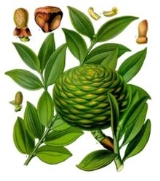
Agathis dammara
Encyclopedia
Agathis dammara is a coniferous
timber
tree native to the Moluccas and the Philippines
.
, widespread through out the entire Mesozoic, emerging about 200 million years ago. An extinct genus, Protodammara (which appeared long ago, during the Mesozoic), derives its name from this tree. This tree is a source of dammar gum
, also known as cat-eye resin.
is found in montane forests between 950-1450 metres in far northern Queensland, where rainfall could possibly exceed 18,000 millimetres in areas with no data, based on the evidence that in the cloud forest of the region the soil is so deprived of nutrients that trees cannot grow in some areas leaving only heathland and sphagnum
bogs. Agathis robusta
grows in tropical rainforests on sandy soils near the coast, such as at Fraser Island where it grows in subtropical rainforest although there is no soil, just sand. Agathis ovata
grows between 150-1000 metres in New Caledonia, sometimes in forests, sometimes in open scrubland.
Pinophyta
The conifers, division Pinophyta, also known as division Coniferophyta or Coniferae, are one of 13 or 14 division level taxa within the Kingdom Plantae. Pinophytes are gymnosperms. They are cone-bearing seed plants with vascular tissue; all extant conifers are woody plants, the great majority being...
timber
Lumber
Lumber or timber is wood in any of its stages from felling through readiness for use as structural material for construction, or wood pulp for paper production....
tree native to the Moluccas and the Philippines
Philippines
The Philippines , officially known as the Republic of the Philippines , is a country in Southeast Asia in the western Pacific Ocean. To its north across the Luzon Strait lies Taiwan. West across the South China Sea sits Vietnam...
.
Description
Agathis dammara is a medium-large conifer up to 60 metres in height found in tropical rainforests, growing from sea level to very high mountainous regions where it becomes extremely stunted. It belongs to the southern hemisphere family AraucariaceaeAraucariaceae
Araucariaceae, commonly referred to as araucarians, is a very ancient family of coniferous trees. It achieved its maximum diversity in the Jurassic and Cretaceous periods, when it was distributed almost worldwide...
, widespread through out the entire Mesozoic, emerging about 200 million years ago. An extinct genus, Protodammara (which appeared long ago, during the Mesozoic), derives its name from this tree. This tree is a source of dammar gum
Dammar gum
Dammar gum is obtained from the Dipterocarpaceae family of trees in India and East Asia, principally those of the genera Shorea, Balanocarpus or Hopea. Most is produced by tapping trees; however, some is collected in fossilized form from the ground. The gum varies in colour from clear to pale...
, also known as cat-eye resin.
Taxonomy
When first discovered and listed as a species it was placed in the genus Pinus (Lambert, 1803), and later with Abies, (Poir 1817) the firs, and later with its own genus (Dammara). It was first recognised as being part of Agathis in 1807 when it was listed as Agathis Loranthifolia, and beyond that with species names beccarii, celebica and macrostachys, although it acquired many more names before dammara was settled on.Related species
Agathis is a very diverse genera, although it has only 21 species. Many other Agathis are found in tropical rainforests, many even in temperate forests. Agathis atropurpureaAgathis atropurpurea
The Black Kauri or Blue Kauri is a species of conifer in the Araucariaceae family.It is found only in Queensland, Australia.It is threatened by habitat loss.-Source:...
is found in montane forests between 950-1450 metres in far northern Queensland, where rainfall could possibly exceed 18,000 millimetres in areas with no data, based on the evidence that in the cloud forest of the region the soil is so deprived of nutrients that trees cannot grow in some areas leaving only heathland and sphagnum
Sphagnum
Sphagnum is a genus of between 151 and 350 species of mosses commonly called peat moss, due to its prevalence in peat bogs and mires. A distinction is made between sphagnum moss, the live moss growing on top of a peat bog on one hand, and sphagnum peat moss or sphagnum peat on the other, the...
bogs. Agathis robusta
Agathis robusta
Agathis robusta is a coniferous tree in the family Araucariaceae, native to eastern Queensland, Australia...
grows in tropical rainforests on sandy soils near the coast, such as at Fraser Island where it grows in subtropical rainforest although there is no soil, just sand. Agathis ovata
Agathis ovata
Agathis ovata is a species of conifer, genus Agathis in the Araucariaceae family.It is found only on the southwest Pacific island of New Caledonia.It is threatened by habitat loss.-Habitat:...
grows between 150-1000 metres in New Caledonia, sometimes in forests, sometimes in open scrubland.
External links
- Agathis dammara at the Gymnosperm Database.
- Agathis dammara - Synonyms

